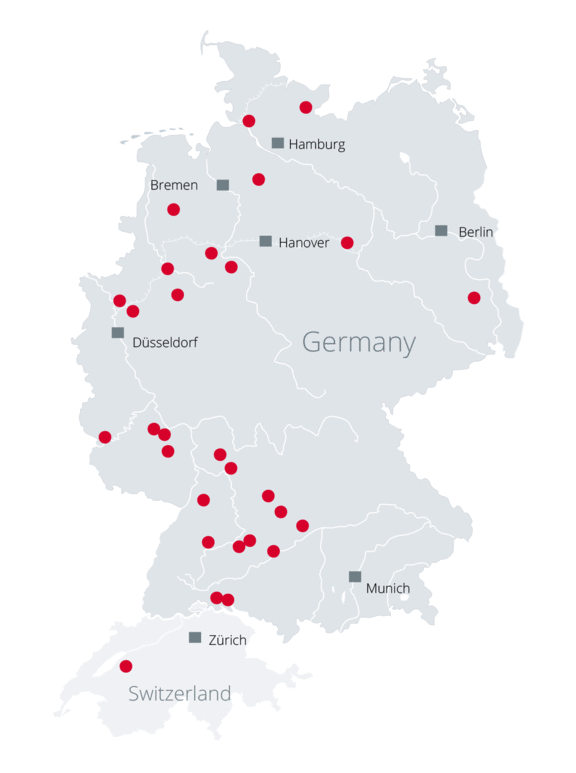Offshore
Onshore
Ichthys Project
Offshore
Steel grade: SAWL450, mild sour
Shipping quanitity: 403,000 t
Australia has emerged as one of the leading producers of liquefied natural gas (LNG). By 2020, the country is poised to overtake Qatar as the biggest global LNG supplier, which is not a surprise, as the majority of the largest LNG projects currently being planned or built are in Australia. The main reason for this is the close proximity to resource-hungry Asian markets. Japan, in particular, is increasing LNG purchases by double-digit growth figures each year. The Fukushima nuclear accident and the resulting shutdowns of nuclear plants have sped up the LNG purchase growth rate even more.
One of the main Australian natural gas supply fields is the Ichthys field, which is located in the Browse Basin off the coast of Western Australia. It is estimated to have a resource base of 12.8 trillion cubic feet of gas, and 527 million barrels of high-value condensate. The first production from the field is expected in 2016.
Gas from this field will be transported by an offshore pipeline to Darwin, the capital city of the Northern Territory in Australia. Near Darwin, a joint venture between INPEX, a mid-size Japanese oil and gas exploration company, Total, the French super major, and various Japanese energy companies is building the Ichthys liquefied natural gas (LNG) terminal. The entire Ichthys project will cost more than USD 34 billion and will initially supply more than 8.4 million tonnes of LNG per year, which makes this project one of the largest LNG export facilities in Australia.
The offshore pipeline which connects the Ichthys field with the Ichthys LNG terminal is 890 km long in total and uses large-diameter pipes with an outside diameter of 42 inches. It will be laid in water depths of between 255 and 280 metres. EUROPIPE has won the order for 60 % of the total pipe volume, which represents 533 km, or 403,000 tonnes, of large-diameter pipes. This includes all 758 buckle arrestors and 29 induction bends for this project. We are proud to have been able to secure this first ever Australian line pipe order for EUROPIPE.
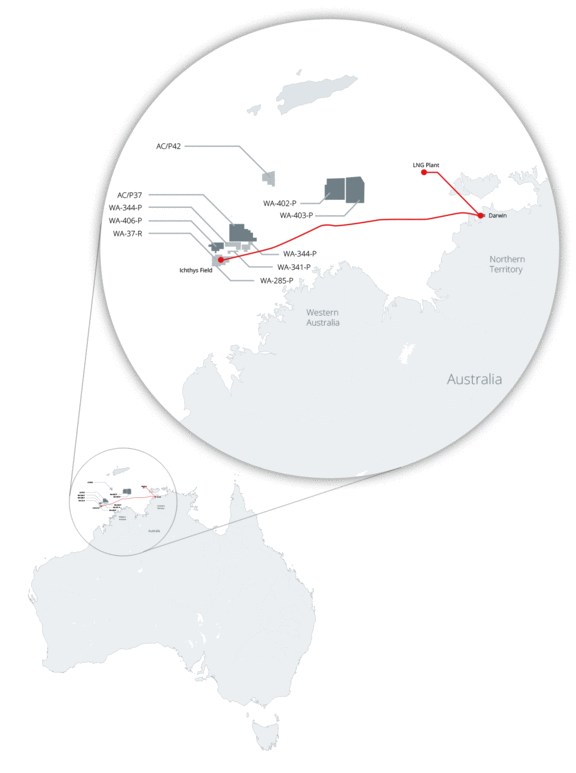
Wheatstone Slug Catcher
Offshore
Steel grade: X65M
Shipping quantity: 7,000 t
The Wheatstone and Iago gas fields are located approximately 200 km off the coast of Western Australian.
Natural gas from these fields primarily feeds an LNG terminal at Ashburton North, near Onslow on the Pilbara coast of Australia, via a 200-km trunkline pipeline.
The LNG complex is built by Chevron Australia and is called the Wheatstone Gas Project. It will cost more than US$ 29 billion when completed. The foundation project will consist of two liquefied natural gas (LNG) trains with a combined capacity of 8.9 million tonnes per annum, plus a 200-terajoules-per-day domestic gas plant. The project has approval to expand to 25 million tonnes per annum of LNG, with the first LNG expected in 2016.
Most of the current LNG capacity will be delivered to Japan, as the country tries to reduce its reliance on nuclear power.
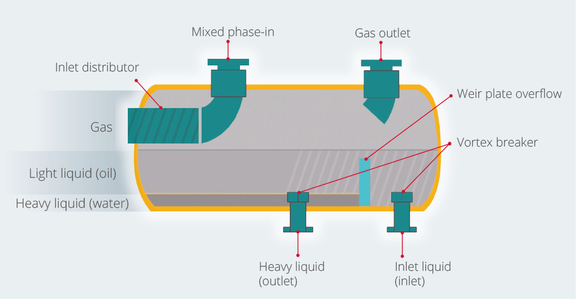
Once the gas from the two fields has arrived onshore at Ashburton North, the gas and condensate will be processed further. One of the key components includes a slug catcher to separate the gas and slugs.
Slug catchers are phase separators and are placed at gas fields and in front of refineries (dual-phase pipelines) to clean natural gas by separating gas oil, water and slugs. EUROPIPE has received an order from Taylor Forge Engineered Systems, Inc. and Bechtel, one of the main contractors of the Wheatstone project, for the delivery of 7.3 km (7,200 tonnes) of large-diameter pipes with an outside diameter of 1,219 mm and wall thicknesses of between 33.32 mm and 43.18 mm in the steel grade X65M. The pipes were delivered to Taylor Forge, a specialist company focussed on engineering and manufacturing slug catchers and other equipment for the oil and gas industry.
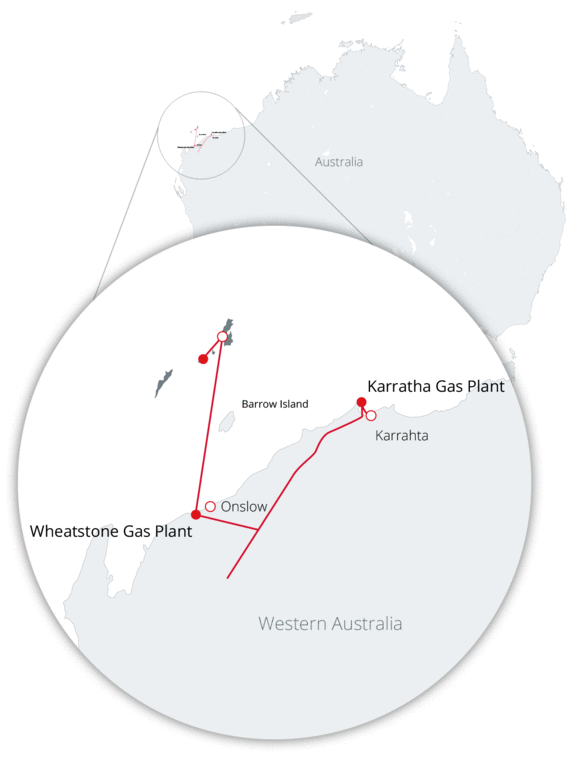
Pappa Terra
Tension Legs
Steel grade: Modified X70
Shipping quantity: 6,500 t
Deep-water oil rigs take various forms, depending on the environment, water depth and production systems. One of the most common forms is the tension leg platform (TLP), in which the oil rig is moored to the seabed with tension legs consisting of large-diameter pipes. These tension legs are drilled up to 200 metres into the seabed, holding the rig under permanent tension.
TLPs have historically been limited to working at a depth of around 1,524 m (5,000 ft), due to tendon design and installation restrictions. The most modern TLP design has been developed by FloaTEC, a joint venture between Keppel FELS and J Ray McDermott. They are called extended tension leg platforms (ETLP) and have significant cost and operational advantages over the standard TLP designs. ETLPs have moved the platform’s columns inboard and extended the pontoons to the tendon porch. This reduces the span between the columns, in turn reducing the amount of structural steel required for the hull.
EUROPIPE has participated in two ETLP projects for FloaTEC in 2011, one in the Gulf of Mexico and one in Brazil.
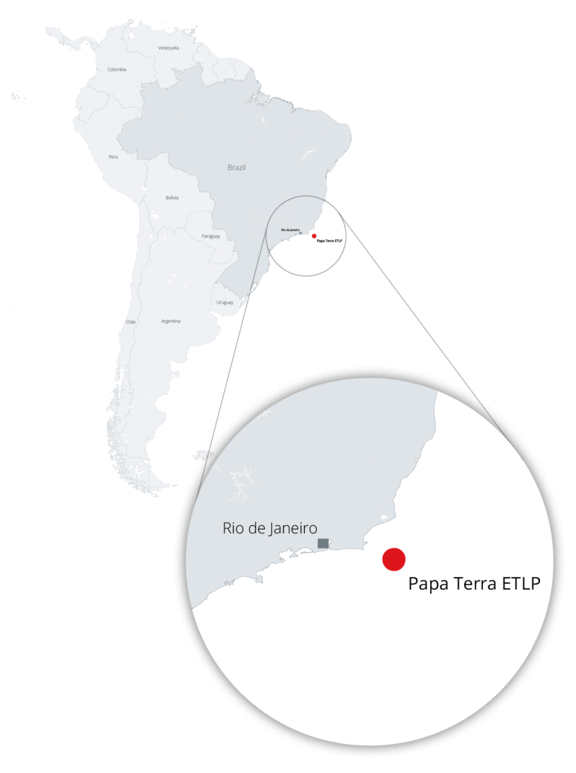
Block 17 | Total
Offshore
Steel grade: X65
Shipping quanitity: 20,000 tonnes
Over the course of the last 7 years, Angola has emerged as the largest oil producer in Africa, overtaking Nigeria in 2008. An OPEC member since 2007, it has the biggest cumulative investment plans in this organisation. More than USD 35 billion has been committed by energy companies for investments in the expansion of the energy infrastructure in Angola. The French supermajor TOTAL S.A. is the leading international energy company in Africa and one of the major oil producers in Angola. TOTAL‘s principal production asset in this country is a deep offshore field called Block 17, where TOTAL has a joint venture with the Angolan national oil and gas company SONANGOL.
Associated gas from this and other oil fields off the coast of Angola will be transported via a system of offshore pipelines to a new gas liquefaction plant near Soyo.
The new LNG plant will commence production in 2012 with a capacity of 5.2 million tonnes of LNG production per year, with the main export markets being the USA and Europe. The gas from this field used to be flared; however, environmental concerns and high gas prices have changed the economics of this type of production. The valorisation of this commodity is now a viable business model.
EUROPIPE has been awarded the order by TOTAL for the delivery of pipes for a pipeline starting from Block 17. This pipeline will be part of a network supplying gas to the new Angola LNG plant. EUROPIPE has supplied nearly 20,000 tonnes of pipe with an OD of 24" (610 mm) and a wall thickness of 1.17" (29.7 mm). For a large-diameter pipe this is a relatively small OD. Combined with the thickness of the pipe wall this constituted a challenge in manufacturing, as the degree of steel deformation was extremely high. In addition, the very sour characteristic (PH 3) of the medium transported required X65 high-purity steel to fulfil the very demanding requirements concerning corrosion resistance. Combined, these very high technical specifications were successfully met, which can be attributed to the close collaboration of the steel and plate mills and the EUROPIPE manufacturing units. The pipes were manufactured on the 18 m line in the EUROPIPE Mülheim mill in March / April 2008, with the inside and protective outside coatings for the pipes provided by MÜLHEIM PIPECOATINGS.
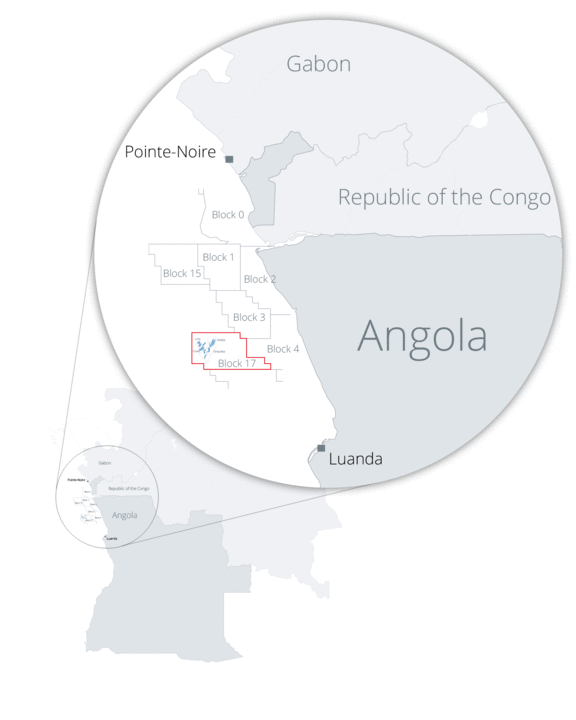
NEL Pipeline
Onshore
Steel grade: L485 MB
Shipping quantity: 113,000 tonnes
The Nordeuropäische Erdgasleitung / Northern European Natural Gas Line (NEL) is the last piece in the new natural gas transmission corridor from Russia to Europe. The core of this corridor is the Nord Stream offshore pipeline, starting in Vyborg, Russia, traversing the Baltic Sea and ending in Greifswald, Germany. On the German side, the Nord Stream Pipeline feeds the OPAL (Ostsee-Pipeline-Anbindungs-Leitung / Baltic Sea Pipeline Link) and NEL Pipelines.
The whole system, which starts in Vyborg, Russia, has a total pipe length of 3,350 km, of which EUROPIPE is delivering nearly 2,800 km or 84 %. We are proud to have been chosen as the leading large-diameter pipe supplier in this very demanding project.
The OPAL Pipeline runs from Greifswald into southern Germany and the NEL Pipeline from Greifswald into north-western Germany, ending in Rehden. Here the gas is either stored or fed into the existing gas transmission pipeline system.
The NEL Pipeline has a length of 440 km and was an order by Wingas with a 75 % share (330 km) and E.ON Ruhrgas with a share of 25 % (110 km). The shareholders are, next to E.ON Ruhrgas and Wingas, the Dutch gas pipeline infrastructure operator Gasunie. In addition Fluxys, the Belgian energy infrastructure provider, will acquire a 19 % share in the pipeline. The total investment for the NEL project is approximately EUR 1 billion.
The pipeline will have a capacity of more than 20 billion cubic metres per year and an operating pressure of 100 bars. It will be constructed between 2011 and 2012. The outside diameter of the 18 m long L485MB pipes is 56" (1,422 mm) with a wall thickness of 22.3 mm. EUROPIPE has produced 113,000 tonnes of large-diameter pipes for this project in 2010 out of a total of 350,000 tonnes.
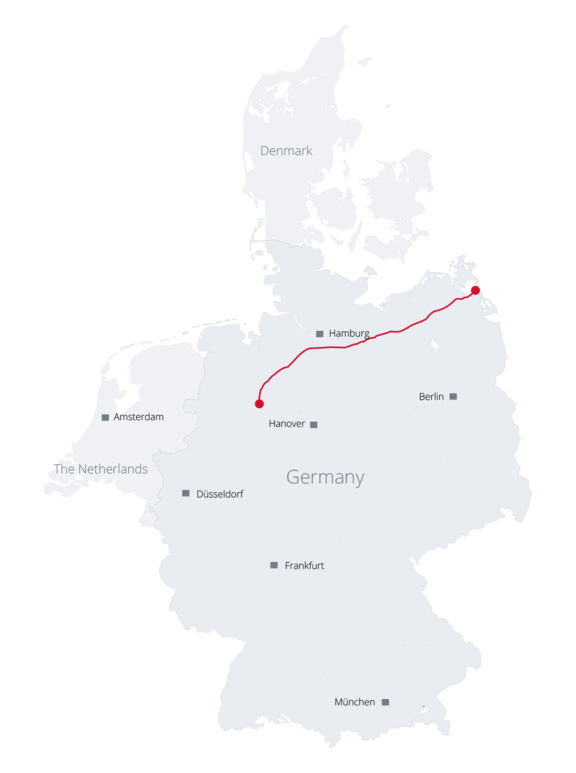
Ruby Pipeline | USA
Onshore
Steel grade: X70
Shipping quantity: 175,390 tonnes
The El Paso Corporation was the largest owner of interstate gas pipelines in the US before it was acquired by Kinder Morgan. Kinder Morgan now operates approximately 70,000 miles of gas pipelines which transport about 40 % of all gas consumed in the US.
The Ruby Pipeline was the first carbon neutral interstate pipeline in North America. It runs from the Opal Hub in Wyoming through Utah and Nevada until it ends near Malin in Oregon. The main aim of this pipeline is to connect the natural gas reserves in the Rocky Mountain region with the markets in the western United States.
The contract to supply 278 miles of large-diameter pipes for this 680 mile long pipeline was awarded to Berg in 2008. Berg Spiral in Mobile produced about 103 miles, Berg Pipe in Panama City, FL about 126 miles and EUROPIPE the balance of about 59 miles. Despite these logistical challenges, our experts around the world were able to supply the pipes with the required quality on time.
The pipes had an outside diameter of 42" (1,066.8 mm) and a wall thickness of between 0.541" (13.7 mm) and 0.600" (15.2 mm). The grade for this order was X70.
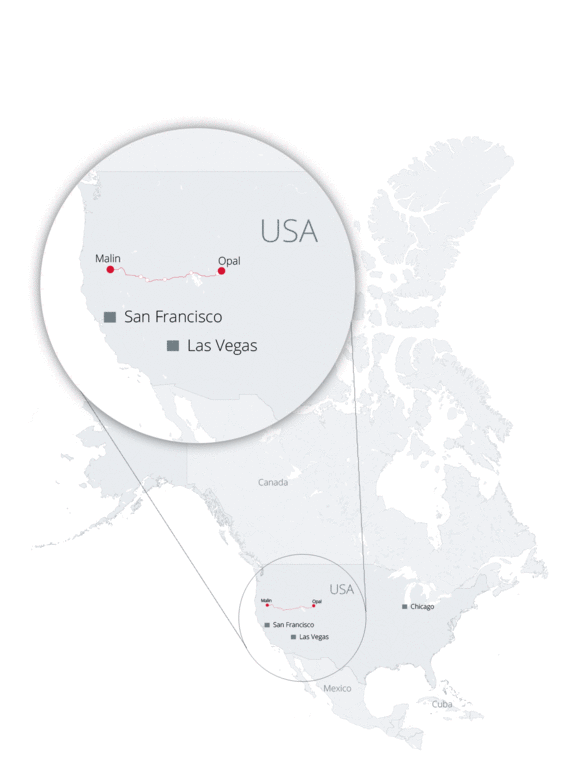
Hauts de France
Onshore
Steel grade: L485 MB
Shipping quantity: 37,000 tonnes
France, due to its size and geographic location, is at the centre of the western European gas network. The dominant gas transmission company in France is GRTgaz, which is majority owned by GDF Suez. It operates a pipeline network of more than 32,000 km, mainly in France. One part of this pipeline network is the Hauts de France pipeline. It was originally built in 1996, with pipes delivered by one of the EUROPIPE predecessor companies. The pipeline connects compressor stations at Pitgam and Cuvilly in north-western France.
Hauts de France had to increase its capacity due to the investment of a subsidiary of EDF, the French electricity company, in an LNG terminal in Dunkerque. The terminal will be the largest of its kind in France, having an annual regasification capacity of 13 billion m3 of gas. It is expected to come into service by the end of 2015 and will boost France's capacity to import natural gas by 20 %.
The pipeline project, called Hauts de France II, consists of two parts. The first one is 17 km long and connects the new LNG terminal to the original starting point of Hauts de France at Pitgam. The second part is 174 km long and runs parallel to the Hauts de France I pipeline, ending in Cuvilly.
EUROPIPE has won the order to supply 58 km (37,000 tonnes) of large-diameter pipes (48"), of which 46 km have a wall thickness of 19.3 mm, and 12 km have a wall thickness of 28.2 mm. The steel grade is L485.
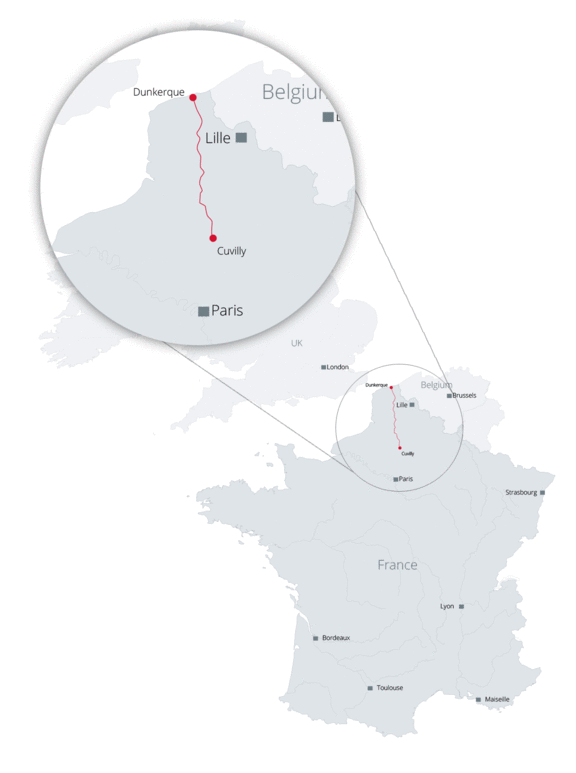
Mirfa-Habshan
Onshore
Steel grade: X65
Shipping quantity: 19,825 tonnes
EUROPIPE has produced large-diameter pipes for an onshore pipeline in Abu Dhabi, transporting nitrogen to help enhance the oil and gas recovery of the large Habshan oil field.
The nitrogen is produced in Mirfa by a joint venture formed by the Linde Group with the Abu Dhabi National Oil Company (ADNOC) called Elixier. It was established to build and operate nitrogen plants in the oil and gas-rich United Arab Emirates. The first plant was built in Ruwais, the second in Mirfa. The plant has two trains with the capacity to produce 670,000 standard cubic metre per hour (scm/h) of nitrogen, which is transported to the Habshan oil and gas fields through a pipeline at a pressure of 60 bars.
The nitrogen is then used for an oil extraction technique called Enhanced Oil Recovery (EOR). It is a tertiary production technology, which increases reservoir rock permeability by creating fractures within the matrix of rock formations. Nitrogen is pumped into the formation, building up a constant pressure level that enables the oil to be pumped to the surface more evenly to secure future supplies. Nitrogen is an ideal gas for EOR as it does not react with the compounds in natural gas, nor does it corrode steel or other materials in the recovery chain. Another method is the use of CO2, extracted from underground wells or captured from power stations. The disadvantage of the CO2method is that a much higher injection pressure is needed to create the same amount of pressure in the formation.
In the Habshan field, nitrogen replaces the secondary production technology in which natural gas is pumped into the reservoirs. This means that the natural gas ADNOC is currently using for this purpose can be used for power generation. The majority of the oil produced from the Habshan fields is then transported via an onshore pipeline to Fujairah on the Gulf of Oman. The large-diameter pipes used for this oil pipeline were supplied by the EUROPIPE Group as well.
EUROPIPE has delivered 43 km of 48" (1,219 mm) pipes with wall thicknesses between 14.3 and 22.2 mm for the Mirfa-Habshan nitrogen pipeline. All pipes were produced in the EUROPIPE mill at Dunkerque, France and were coated with 3-layer Polyethylene.
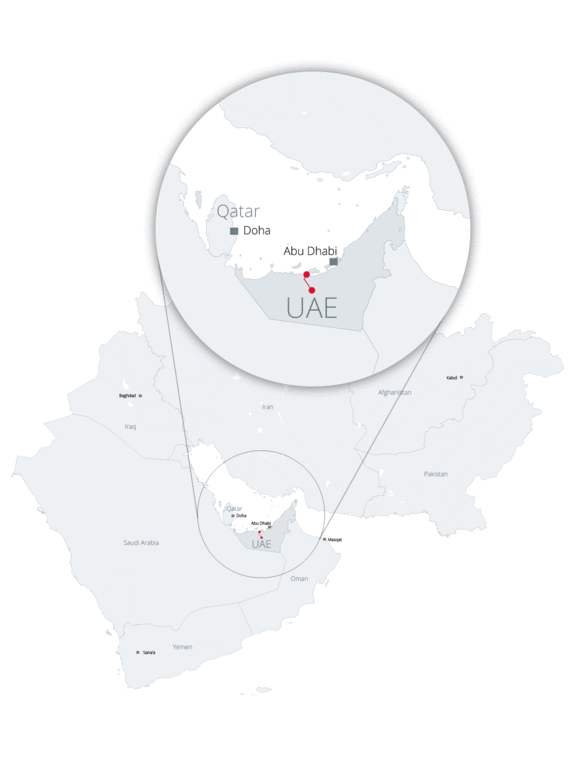
OPAL
Onshore
Steel grade: L485 MB
Shipping quantity: 37,000 tonnes
The OPAL pipeline (Ostsee-Pipeline-Anbindungs-Leitung – Baltic Sea Pipeline Link) will be built by a joint-venture of WINGAS GmbH & Co. KG and E.ON Ruhrgas AG. With a total investment volume of around EUR 1 billion, it is one of the largest pipeline projects ever to be undertaken in Germany.
It will connect the European gas grid to the major natural gas reserves in Siberia via the Nord Stream Pipeline, to which it is to be linked up in Lubmin near Greifswald and transport the gas 470 kilometres south to Olbernhau on the Czech border.
More than 35 billion cubic metres of natural gas will flow through the OPAL every year, which equals about a third of Germany’s overall natural gas requirements. EUROPIPE is the sole large-diameter pipe supplier. We have produced 380,000 tonnes of pipes with a diameter of 56" (1,422 mm) and a wall thickness of 22.3 mm for the OPAL.
The logistics for this project were very demanding, as the pipeline will be built in 14 sections, with 55 pipe storage depots in total. Each pipe weights nearly 15 tonnes, which is why only one pipe per truck can be transported. This means EUROPIPE had to organise not only the railway transport, but also nearly 27,000 truck trips from the respective railway stations to the storage depots.
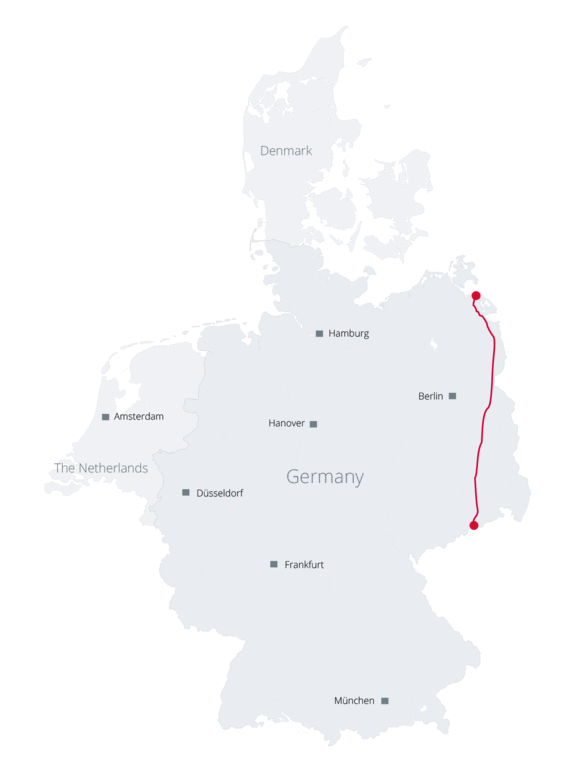
Optimising Pipelines
Onshore
This product range has been developed for localised gas storage requirements of clients in the power station sector, primarily municipal utilities. The EUROPIPE Optimising Pipelines are suited for short-term gas storage of small to medium-size quantities in closer proximity to power stations.
In 2008 EUROPIPE received two orders totalling 24 km of pipes from RWE Power, the largest orders in this market segment so far. They constitute a new dimension of projects, as these are the first large orders from a non-municipal utility.
The first order was for the delivery of 15 km of large-diameter pipes for the extension of the RWE Emsland power station in Lingen. The gas and steam turbine powered station has a net capacity of 876 MW and is come into operation in 2009. The second order was a 9 km pipe system for the RWE Gerstein power station in Hamm-Werne. The total number of pipes produced for these orders was 1,400, and they have a diameter of 56" (1,422 mm) and a wall thickness of 24 mm.
The pipes were constructed in parallel lines with caps at each end of the line. The technical specifications were very demanding, as the pipes have to withstand at least one load cycle per day, with an operating pressure fluctuation between 30 and 100 bar. In addition, very high requirements regarding roundness and wall thickness tolerances had to be met.
